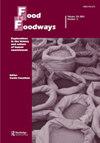Say no to bat fried rice: changing the narrative of coronavirus and Chinese food
IF 1.1
Q2 ANTHROPOLOGY
引用次数: 12
Abstract
Abstract The fear of Chinese food in the United States has risen with the advent of COVID-19, amidst widespread news reports pinpointing a wildlife wet market in Wuhan, China as the origin site of the novel coronavirus. Although scientific evidence for the exact pathway of zoonotic transmission is not yet conclusive, racist, anti-Chinese memes were quick to circulate, including a T-shirt design posted on social media by an art director at Lululemon, which featured an image of “bat fried rice” with the words “No Thank You” in chopstick font on the sleeves. It is important to address the facts of wildlife trade and consumption in China, but it is equally crucial to fight back against racist characterizations of Chinese food as “bat fried rice” with a different kind of Instagrammable image. I have taught an undergraduate seminar on the cultural history of Chinese food at the University of North Carolina at Chapel Hill for the past eight years, and this year, one of my students shared a photograph of a Chinese family celebrating the New Year in one of her assignments. This image distilled everything I associate with Chinese food— the joy of gathering with family—and stands as a powerful rebuke to the narrative of fear and disgust, replacing it instead with a vision of Chinese food as familiar source of comfort.对蝙蝠炒饭说不:改变冠状病毒和中国食物的叙述
摘要随着新冠肺炎的到来,美国对中国食物的恐惧加剧,广泛的新闻报道指出中国武汉的一个野生动物湿货市场是新型冠状病毒的起源地。尽管人畜共患传播确切途径的科学证据尚不确凿,但种族主义、反华的模因很快就流传开来,包括Lululemon艺术总监在社交媒体上发布的一件T恤设计,上面有一张“蝙蝠炒饭”的图片,袖子上用筷子字体写着“不,谢谢”。解决中国野生动物贸易和消费的事实很重要,但同样重要的是,用不同的Instagram图片回击将中国食物描述为“蝙蝠炒饭”的种族主义行为。在过去的八年里,我在北卡罗来纳大学教堂山分校教授了一个关于中餐文化史的本科生研讨会。今年,我的一名学生在她的一份作业中分享了一张中国家庭庆祝新年的照片。这张照片提炼了我与中国食物联系在一起的一切——与家人团聚的快乐——并有力地谴责了恐惧和厌恶的叙事,取而代之的是将中国食物视为熟悉的安慰来源。
本文章由计算机程序翻译,如有差异,请以英文原文为准。
求助全文
约1分钟内获得全文
求助全文
来源期刊

Food and Foodways
ANTHROPOLOGY-
CiteScore
2.20
自引率
0.00%
发文量
16
期刊介绍:
Food and Foodways is a refereed, interdisciplinary, and international journal devoted to publishing original scholarly articles on the history and culture of human nourishment. By reflecting on the role food plays in human relations, this unique journal explores the powerful but often subtle ways in which food has shaped, and shapes, our lives socially, economically, politically, mentally, nutritionally, and morally. Because food is a pervasive social phenomenon, it cannot be approached by any one discipline. We encourage articles that engage dialogue, debate, and exchange across disciplines.
 求助内容:
求助内容: 应助结果提醒方式:
应助结果提醒方式:


